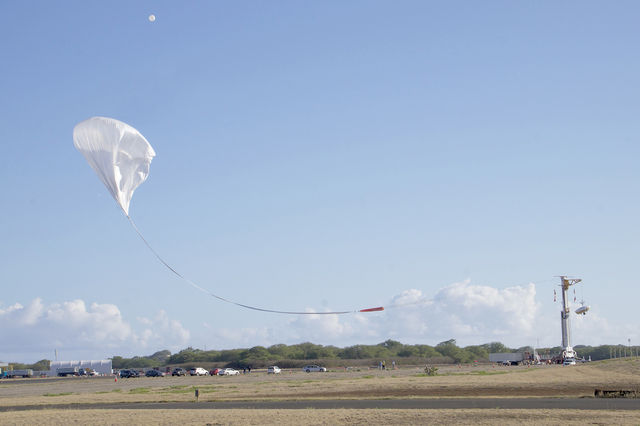NASA and Pacific Missile Range Facility employees raised their eyes to the sky and smiled Monday as they watched the successful launch of NASA’s new “flying saucer.” “Everything went well this morning,” said Keith Koehler, NASA spokesman. “The balloon launch
NASA and Pacific Missile Range Facility employees raised their eyes to the sky and smiled Monday as they watched the successful launch of NASA’s new “flying saucer.”
“Everything went well this morning,” said Keith Koehler, NASA spokesman. “The balloon launch was very fine.”
There was one problem.
Although the saucer’s parachute deployed, a NASA press release stated it failed to inflate on descent. Another giant parachute also failed to inflate during a similar NASA test of new Mars spacecraft technology last year. One of the main goals this year was to test the redesigned parachute.
Having been delayed for a week due to weather concerns, the launch of NASA’s Low Density Supersonic Decelerator went off at 7:45 a.m. at PMRF. The purpose was to test new technologies that could one day deliver large payloads — and eventually astronauts — to Mars. The technology is designed to slow down a landing vehicle falling through the atmosphere at supersonic speeds.
Jonathan Williams, PMRF technology evaluation program manager and operations conductor, was pleased with the test.
“Today was much better than the first time,” Williams said. “NASA’s mission last year was the first of its kind.”
The test required a helium-filled balloon to lift the LDSD 23 miles into the atmosphere just west of Kauai, where it expanded to the size of a football stadium and dropped the device. A rocket motor attached to the decelerator launched it further, to a height of 34 miles at a speed of Mach four, also known as four times the speed of sound. The height also allowed NASA to simulate the Martian thin atmosphere, Koehler said.
However, the real test for the device began as the LDSC descended toward Earth; a process that took between 15 and 20 minutes.
As the saucer began to fall toward the Pacific Ocean, a large inflatable cushion known as the Supersonic Inflatable Aerodynamic Decelerator inflated 20 feet around the device to slow its decent.
The parachute deployed but failed to inflate, Kimberly Newton, a spokeswoman for NASA, said in an email. The agency plans to provide more details during a news conference today.
The LDSD was damaged in the ocean landing.
The supersonic parachute is 100 feet in diameter, about twice as big as the one that carried the Curiosity rover to Mars in 2012.
Ten cameras attached to the LDSD analyzed the parachute and other parts. NASA scientists will process the information.
“They all help reconstruct what took place,” Williams said.
The LDSD is only one of the projects NASA is working on in order to allow future explorations beyond Earth including Mars, asteroids and beyond. NASA has said it wants to send astronauts to Mars in the 2030s.
This is the second time NASA has performed the LDSD test on Kauai.
Williams said that he was proud to have PMRF host NASA’s project.
“From PMRF’s standpoint, it only adds to our pedigree about the programs we support and how successful we make those programs by the facilities we offer,” he said.
•••
The Associated Press contributed to this report.



